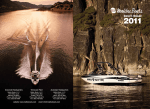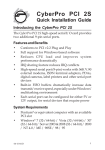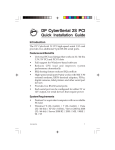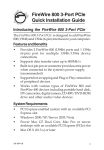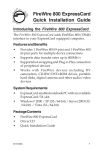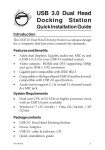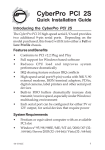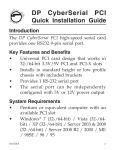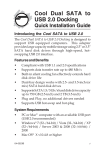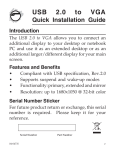Download Siig JU-SW4112
Transcript
USB 2.0 Switch Quick Installation Guide Introducing the USB 2.0 Switch The USB 2.0 Switch is designed to share USB device(s) between multiple systems. Features and Benefits • • • Compliant with USB Specifications, Revision 2.0. Hot-swapping feature allows you to attach/detach USB devices without powering down your computer Use keyboard Hotkey control (Windows only) or Power LED/Manual switching button to switch between computers Designed for USB devices including printers, scanners, hard disk drives, cameras, CD-ROMS and Zip drives. Note: Not designed to work with keyboard or mouse System Requirements • • • 04-0318C PC or Mac® computer with an available USB port (USB 2.0 recommended) Windows® 7 (32-/64-bit) / Vista (32-/64-bit) / XP (32-/64-bit) / Server 2003 & 2008 (32-/64-bit) / 2000/ ME / 98SE Mac OS® X v10.0 or later 1 Package Contents • • • USB 2.0 Switch USB cables (6 Ft, Type A to Type B) Software CD and quick installation guide Layout Do not connect the USB 2.0 Switch to your system until after the driver has been installed. Please refer to the Installation section starting on page 4 to install its driver. USB 2.0 Switch 2-to-1 • • • Two Type B connectors for system connection One Type A connector for device connection Convenient manual switching buttons To PC (Type B connector) Power LED/Manual switching button To USB device (Type A connector) Figure 1. USB 2.0 Switch 2-to-1 2 USB 2.0 Switch 4-to-1 • • • Four Type B connectors for system connection One Type A connector for device connection Convenient manual switching buttons Power LED/Manual switching button To PC (Type B connector) To PC (Type B connector) To USB device (Type A connector) Figure 2. USB 2.0 Switch 4-to-1 3 Windows Installation Important: Do not connect the USB 2.0 Switch to your system until after the driver has been installed. In order for the driver to install properly the Power LED to that system must be switched to another system. For example, if you connect port A to system A, make sure the Power LED on port A is not lit. Windows 7 (32-/64-bit) / Windows Vista (32-/64-bit) 1. 2. 3. 4. 5. 6. 4 Insert the driver CD after Windows boots. At the AutoPlay box: Click Run Setup.exe If AutoPlay doesn't start: Click Start, in Start Search type D:\Setup.exe, press Enter. (Change D: to match your CD/DVD-ROM drive letter) At User Account Control, click Allow. Select your language, then click OK. Click Next, Next, then Finish. Plug the USB 2.0 Switch into an available USB port (USB 2.0 recommended) with the supplied USB cables and the driver will install automatically. Press the Power LED/Manual switching button that matches the system to complete the installation. Windows XP (32-/64-bit) / Server 2003 (32-/64-bit) 1. 2. 3. 4. 5. 6. Insert the driver CD after Windows boots. AutoRun should start the installation. If AutoRun doesn't start, click Start, Run, type D:\setup.exe, then click OK. (Change D: to match your CD/DVDROM drive letter) Select your language, then click OK. Click Next, Next, then Finish. Plug the USB 2.0 Switch into an available USB port (USB 2.0 recommended) with the supplied USB cables and the driver will install automatically. Press the Power LED/Manual switching button that matches the system to complete the installation. Windows Server 2008 (32-/64-bit) 1. 2. 3. 4. 5. Insert the driver CD after Windows boots. At the AutoPlay box: Click Run Setup.exe. If AutoPlay doesn't start: Click Start, in Start Search type D:\Setup.exe, press Enter. (Change D: to match your CD/DVD-ROM drive letter) Select your language, then click OK. Click Next, Next, then Finish. Plug the USB 2.0 Switch into an available USB port (USB 2.0 recommended) with the supplied USB cables and the driver will install automatically. Press the Power LED/Manual switching button that matches the system to complete the installation. 5 Windows 2000 / ME 1. 2. 3. 4. 5. 6. Insert the driver CD after Windows boots. AutoRun should start the installation. If AutoRun doesn't start, click Start, Run, type D:\setup.exe, then click OK. (Change D: to match your CD/ DVD-ROM drive letter) Select your language, then click OK. Click Next, Next, then Finish. Restart Windows. When Windows resumes, plug the USB 2.0 Switch into an available USB port (USB 2.0 recommended) with the supplied USB cables and the driver will install automatically. Press the Power LED/Manual switching button that matches the system to complete the installation. Windows 98SE 1. 2. 3. 4. 5. 6. 6 Insert the driver CD after Windows boots. AutoRun should start the installation. If AutoRun doesn't start, click Start, Run, type D:\setup.exe, then click OK. (Change D: to match your CD/DVDROM drive letter) Select your language, then click OK. Click Next, Next, then Finish. Restart Windows. When Windows resumes, plug the USB 2.0 Switch into an available USB port (USB 2.0 recommended) with the supplied USB cables. When Windows prompts for the driver, click Next. 7. 8. Select Search for the best driver..., and click Next. Clear all check boxes, click Next, click Next again. Note: If prompted for Windows Installation CDROM, click OK. Insert this CD, then click OK again. 9. Click Finish. If prompted, click Yes to restart. To Verify Windows Installation 1. 2. Go to Device Manager to verify installation. For Windows 7: Right click Computer, click Manage, then click Device Manager. For Windows Vista: Right click Computer, click Manage, click Continue, then click Device Manager. For Windows XP / Server 2003 / 2000: Right click My Computer, click Manage, then click Device Manager. For Windows Server 2008: Right click Computer, click Manage, double click Diagnostics, then click Device Manager. For Windows ME / 98SE: Right click My Computer, click Properties, then click Device Manager. Depending on the status of the Power LED/Manual Switching Button, use the option that best matches the system. Power LED is lit: Double click Universal Serial Bus controllers and Generic USB Hub should be displayed. 7 Power LED is off: Double click Human Interface Devices. HID-compliant device and either USB Human Interface Device or USB Input Device should be displayed. Windows Device Switching Hotkey Control, Status Indicator and Manual switching button are the three methods that can be used to switch devices between systems. Note: For Mass Storage devices such as flash drives, USB memory card readers and CD-ROMs, before switching the USB device to another system, it must be released from the system that controls it. Use Windows Safely Remove Hardware feature, located in the taskbar, to Stop the USB device. Hotkey Control Press Ctrl+F11 to switch the USB device to the current system. Status Indicator 1. 8 The Status Indicator is located in the taskbar by the system clock. The indicator has three functions: Red: Another system is accessing the device switching not allowed. Green: The current system controls the device. Yellow: No system controls the device - switching is allowed. 2. 3. Double click the USB Sharing icon to start USB sharing program manually. Right click the Status Indicator and select Switch can also switch USB access to the current system. Note: Devices such as external hard drives and printers send signals back and forth to your computer when they are connected. This causes the Status Indicator to remain red. Switching is still possible by clicking Yes in the Enforce Switching pop-up box. Manual Switching Button Press a Power LED/Manual switching button to switch to another system. Mac OS Installation No driver installation is necessary. Simply plug the USB 2.0 Switch into an available USB port (USB 2.0 recommended). Mac OS Device Switching Device switching is controlled by the Power LED/Manual switching button. Follow the instructions in the next section for your device type. 9 Memory Card Readers 1. 2. 3. Drag the memory card's drive icon into the Trashcan. Remove the memory card from the card reader then press a switching button to change systems. Insert a memory card into the memory card reader. Mass Storage Devices CD-ROMs, flash drives, external hard disk drives, and Zip drives typically add drive icons to the desktop. Use the directions below for switching these devices. 1. 2. 3. Drag the drive icon into the Trashcan. Press the switching button to change systems. The drive icon will appear on the other system. Other Devices For other devices just press the switching button to change to another system. Connecting USB Devices When connecting your USB device(s) to the USB 2.0 Switch, follow the USB device's driver installation procedures. 10 Technical Support and Warranty QUESTIONS? SIIG’s Online Support has answers! Simply visit our web site at www.siig.com and click Support. Our online support database is updated daily with new drivers and solutions. Answers to your questions could be just a few clicks away. You can also submit questions online and a technical support analysts will promptly respond. SIIG offers a 5-year manufacturer warranty with this product. Please see our web site for more warranty details. If you encounter any problems with this product, please follow the procedures below. If it is within the store's return policy period, please return the product to the store where you purchased from. If your purchase has passed the store's return policy period, please follow these steps to have the product repaired or replaced. Step 1: Submit your RMA request. Go to www.siig.com, click Support, then RMA to submit a request to SIIG RMA. Your RMA request will be processed, if the product is determined to be defective, an RMA number will be issued. Step 2: After obtaining an RMA number, ship the product. • Properly pack the product for shipping. All accessories that came with the original package must be included. • Clearly write your RMA number on the top of the returned package. SIIG will refuse to accept any shipping package, and will not be responsible for a product returned without an RMA number posted on the outside of the shipping carton. • You are responsible for the cost of shipping. Ship the product to the following address: SIIG, Inc. 6078 Stewart Avenue Fremont, CA 94538-3152, USA RMA #: • SIIG will ship the repaired or replaced product via Ground in the U.S. and International Economy outside of the U.S. at no cost to the customer. 11 About SIIG, Inc. Founded in 1985, SIIG, Inc. is a leading manufacturer of IT connectivity solutions (including Serial ATA and Ultra ATA Controllers, FireWire, USB, and legacy I/O adapters) that bridge the connection between Desktop/ Notebook systems and external peripherals. SIIG continues to grow by adding A/V and Digital Signage connectivity solutions to our extensive portfolio. SIIG products offer comprehensive user manuals, many user-friendly features, and are backed by an extensive manufacturer warranty. High quality control standards are evident by the overall ease of installation and compatibility of our products, as well as one of the lowest defective return rates in the industry. SIIG products can be found in computer retail stores, mail order catalogs, through major distributors, system integrators, and VARs in the Americas and the UK, and through e-commerce sites. PRODUCT NAME USB 2.0 Switch FCC RULES: TESTED TO COMPLY WITH FCC PART 15, CLASS B OPERATING ENVIRONMENT: FOR HOME OR OFFICE USE FCC COMPLIANCE STATEMENT: This device complies with part 15 of the FCC Rules. Operation is subject to the following two conditions: (1) This device may not cause harmful interference, and (2) this device must accept any interference received, including interference that may cause undesired operation. THE PARTY RESPONSIBLE FOR PRODUCT COMPLIANCE SIIG, Inc. 6078 Stewart Avenue Fremont, CA 94538-3152, USA Phone: 510-657-8688 USB 2.0 Switch is a trademark of SIIG, Inc. SIIG and the SIIG logo are registered trademarks of SIIG, Inc. Microsoft and Windows are registered trademarks of Microsoft Corporation. Mac and Mac OS are registered trademarks of Apple Computer. All other names used in this publication are for identification only and may be trademarks of their respective owners. April, 2010 Copyright © 2010 by SIIG, Inc. All rights reserved.












